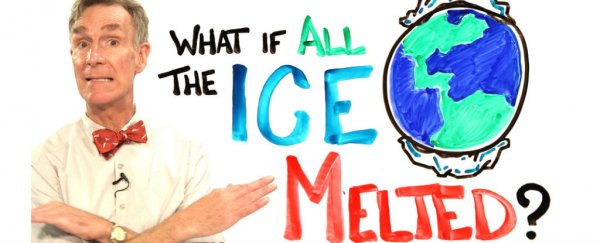
Consider this: only 3 percent of water on Earth is fresh, and 70 percent of that is frozen. That's 30 million cubic km of ice, and if you built that into a 1,000-metre thick wall, it would completely cover North America. But what if all that ice melted?
As the latest episode of AsapSCIENCE explains, ice on Earth comes in the form of glaciers, ice sheets, permafrost, and snow.
Because the Arctic is largely made up of ocean, ice there mainly takes the form of floating blocks such as massive icebergs. And being in direct contact with the warming waters of the ocean, sea ice will be the first form of frozen water to disappear.
This year, NASA reported that the extent of Arctic sea ice was the lowest ever recorded for the months of January, February, April, May, and June. As we reported back in August, things have been so bad for so long, NASA scientists have accepted our terrible levels of sea ice as the "new normal".
"A decade ago, this year's sea ice extent would have set a new record low and by a fair amount," Walt Meier, a sea ice scientist at NASA's Goddard Space Flight Centre, told the press. "Now, we're kind of used to these low levels of sea ice - it's the new normal."
Once all the sea ice melts, you could take a ship directly from Europe to Russia, Bill Nye explains, because there'd be no ice left in the North Pole to block your route. Which is actually a pretty crappy consolation prize when you consider that all the seals, walruses, and polar bears that call the North Pole home would be long gone.
And you might think that marine animals are only getting more habitat if the sea ice melts, but the fact is that 95 percent of ice on Earth is actually land-based. As in, there are entire mountain ranges in Antarctica that are almost as extensive as the Alps, only they're completely covered in ice sheets.
So what if all this ice melted away? I'll let Bill explain that one to you, but let's just say that sea levels would rise by around 70 metres, and half the world's citizens live on sea coasts. So… good luck, us?
Watch the AsapSCIENCE video above to discover the fate that could await our quickly warming planet.
And when you're done, follow the boys as they take a trip to the Arctic to see the effects of climate change first-hand in the video below. It's pretty scary stuff:

